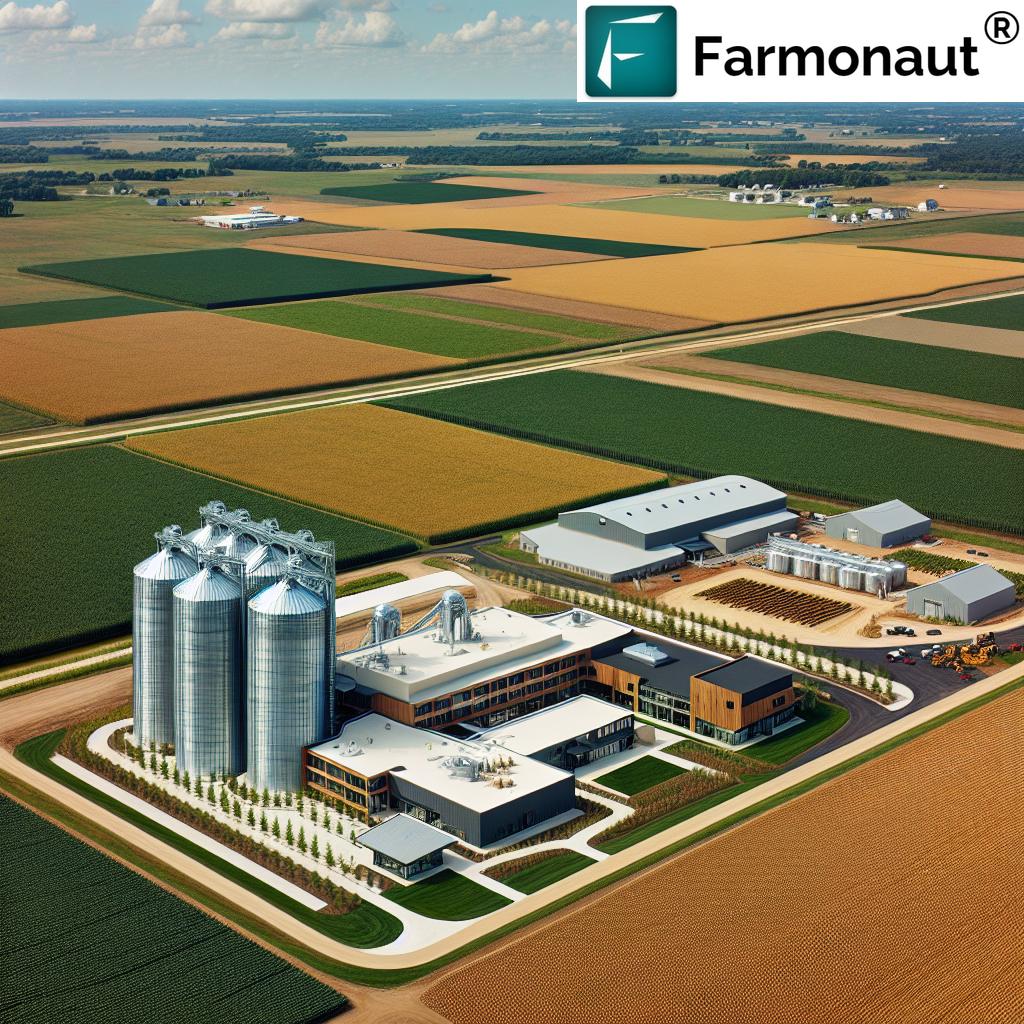“Florida’s orange production dropped over 70% since 2005 due to disease, urbanization, and hurricanes.”
Florida Orange Groves Development: 7 Revival Strategies
Florida’s orange groves, once iconic and fundamental to the state’s agricultural heritage, are now at a crossroads. We are witnessing a striking decline of orange groves largely due to a complex set of challenges—from intensifying disease threats and tumultuous weather, to mounting urban development. Yet, this transformation also uncovers opportunities for innovative solutions that can revitalize citrus production for future generations.
In this comprehensive guide, we will explore the evolution of Florida’s citrus industry, examine the primary factors contributing to citrus grove decline, and detail seven key revival strategies. Our analysis draws on recent research and cutting-edge technology—such as Farmonaut’s advanced agricultural monitoring tools—to illustrate how sustainable practices can stem the tide of acreage loss and economic impact, while safeguarding the cultural heritage of citrus groves in Florida.
Decline of Florida’s Orange Groves: Examining Challenges & Contributing Factors
Over the last two decades, the Florida citrus landscape has been radically altered. In 2000, groves spanned more than 832,000 acres. By 2023, only about 275,000 acres remained. What accounts for this dramatic reduction?
Key Factors Contributing to Florida Citrus Industry Challenges
-
Citrus Greening Disease (Huanglongbing/HLB)
The most devastating bacterial infection reshaping the industry is the citrus greening disease (HLB). Spread by the Asian citrus psyllid, this disease attacks fruit yield and tree quality, eventually resulting in tree death. With no known cure, its impact is severe and long-lasting—making this a singular challenge for all Florida citrus growers.
Reference: Wikipedia – Citrus Production -
Natural Disasters Effect on Agriculture
Florida is regularly battered by hurricanes, storms, and freezes. Hurricane Irma (2017), the storms of 2022, and the 2023 season cumulatively caused multi-million-dollar crop loss and lasting damage to tree health. Recovery often takes years, further testing the resilience of the state’s groves.
Reference: AP News – Citrus Groves Hit by Hurricanes -
Urban Encroachment: The Role of Development
As urban areas expand due to population growth, there’s increasing demand for residential and commercial development. Significant acres of former citrus groves are now transformed into housing and business centers. Notably, large players such as Alico Inc. have initiated plans to cease citrus operations on tens of thousands of acres, fueling this rapid transition.
Reference: AP News – Alico Inc. and Citrus Acreage Conversion
Quantifying the Decline of Orange Groves
- Acreage Reduction: From 832,000 acres (2000) down to approximately 275,000 (2023).
- Production Collapse: Approximately 90% drop in orange output over two decades.
- Direct Impact on Communities: Entire communities reliant on citrus face economic loss, job reductions, and even displacement.
Economic Impact of Citrus Decline
The economic impact of citrus decline reverberates well beyond the groves themselves. Job losses, factory closures, and diminished local spending cascade through affected communities, as highlighted by events such as the Gulf Citrus Growers Association’s closure and Alico Inc.’s redirection towards real estate.
Reference: Farmonaut Blog – Florida’s Citrus Crossroads
Loss of Cultural Heritage and Environmental Change
Citrus groves are not merely economic assets—they are woven into the local culture, heritage, and biodiversity of Florida. Transformation of groves into urban areas disrupts wildlife habitats, impacts microclimates, and leads to the permanent loss of a landscape that is central to the state’s identity.
Urban Development Impact on Agriculture
As Florida’s population growth continues, urban encroachment brings irreversible change to once-rural areas. Let’s break down how this urban development impact on agriculture specifically influences the citrus industry:
- Loss of Grove Acres: Every year, thousands of acres transition from agricultural use to residential and commercial developments.
- Increased Land Values: Rising land values create strong incentives for growers to sell out to developers, further reducing the area available for orange production.
- Environmental Pressure: Conversion of groves leads to implications such as decreased groundwater recharge, increased urban heat, and reduced carbon sequestration capacity of local landscapes.
Given these compounding challenges, how can we revitalize citrus production and preserve the cultural heritage of citrus groves? We turn to innovative strategies next.
“Innovative disease-resistant citrus varieties could boost Florida’s orange yields by up to 40% in coming years.”
Environmental, Economic & Cultural Impact of Citrus Grove Loss and Recovery
Why the Decline of Orange Groves Matters
- Economic Impact: Citrus production is a historical engine of Florida’s rural economies. Its decline reduces employment, personal income, and tax revenue in affected areas.
- Environmental Impact: Mature groves provide ecosystem benefits—refreshing air, supporting pollinators, and maintaining habitat structure for local wildlife.
- Cultural Impact: Festivals, local identity, even county logos are tied to the orange. As these symbols fade, entire communities lose pieces of their shared story.
These intersecting effects highlight a critical truth: revitalizing Florida’s citrus industry isn’t just an economic pursuit—it’s a mission to preserve heritage and environmental function for generations to come.
7 Revival Strategies for Florida Orange Groves
Let’s examine seven innovative strategies for revitalizing citrus production in Florida. Each offers a pathway to overcoming the “Florida citrus industry challenges” we’ve highlighted above:
1. Advanced Research into Disease-Resistant Citrus Trees
- What: Scientists are accelerating efforts to develop genetically modified or conventionally bred citrus trees that demonstrate greater resistance to huanglongbing (HLB) / citrus greening.
- Why: Disease-resistant trees hold the promise of restoring fruit yield and long-term industry sustainability.
- How: Laboratory research, field trials, and collaborative breeding programs are underway. While deployment at commercial scale will take years, this route is considered a potential “game changer” for the industry.
Farmonaut’s Plantation & Advisory Solutions
help growers monitor trial groves, track disease outbreaks remotely, and optimize new plantings using satellite data.
2. Innovative Farming Practices: Wildflowers, Cover Cropping, and Biodiversity Boost
- What: Innovative farming practices Florida—such as planting wildflowers amidst tree rows—boost pollinators and attract beneficial insects that suppress pests.
- Why: Enhancing on-farm biodiversity can reduce pesticide use, improve grove health, and foster natural disease resilience.
- How: By adopting flower strips, cover crops, and alternative row management, growers tackle multiple environmental and pest control challenges with one strategy.
Reference: Axios – Wildflowers in Citrus Groves
Farmonaut’s Carbon Footprinting
tool empowers Florida growers to measure and reduce the environmental impact of innovative grove practices.
3. Precision Agriculture: Satellite Monitoring & AI Data Solutions
- What: Use advanced satellite imagery and AI-powered advisory systems to monitor crop health, soil moisture, and spot early signs of disease, drought stress, or pest infestations, so we can take action proactively.
- Why: Enables resource optimization, targeted input application, and swift intervention—reducing input costs and avoiding unnecessary tree loss.
- How: Platforms like Farmonaut provide real-time monitoring via web and mobile apps, increasing efficiency for both small and large-scale Florida citrus operations.
Farmonaut Satellite & Weather Data API
for integrating real-time satellite insights into your own agtech applications.
Developer Docs:
See Developer Documentation.
4. Blockchain Traceability to Enhance Supply Chain Trust
- What: Use blockchain to track the entire journey of citrus fruit, from grove to market, ensuring transparency in provenance and handling.
- Why: Enhances consumer and buyer trust, bolsters food safety, and can even enable premium pricing for certified, sustainable, or disease-free fruit.
- How: Blockchain systems, like Farmonaut’s
product traceability platform,
support secure record-keeping and instant product authentication.
5. Community and Policy Initiatives: Foundation-Driven Preservation
- What: Community groups and non-profits—such as the Save Florida Citrus Groves Foundation—mobilize to protect and restore abandoned or at-risk groves.
- Why: Foundation programs like “Gift-A-Grove” buy, lease, or steward groves to prevent their conversion into non-agricultural land, keeping the landscape productive.
- How: Public policy, grants, and grassroots organizing work hand-in-hand to secure grove land for future generations.
Farmonaut’s Large-Scale Farm Management Platform
makes stewardship practical at scale with monitoring and record-keeping for preserving agricultural heritage properties.
6. Crop Insurance, Fleet, and Resource Management Technology Adoption
- What: Adoption of advanced fleet management and crop insurance tools reduces both climate risk and operational inefficiency.
- Why: Managing fleets of tractors, spray units, and harvesters optimally can reduce fuel use and maximize acreage covered during critical events. Satellite-based insurance verification helps expedite recovery after storms or freezes.
- How: Farmonaut offers fleet management and crop insurance verification solutions to protect groves and bank on reliable disaster recovery.
7. Regenerative Approaches: Soil Health, Water Conservation, and Low-Input Models
- What: Use regenerative techniques—like mulching, composting, minimal tillage, and targeted water management—to improve soil health and boost grove resilience naturally.
- Why: These methods increase organic matter, reduce need for synthetic inputs, and can make trees less susceptible to environmental stress and disasters.
- How: By maintaining robust soil biology and reducing chemical dependency, growers can gradually lower costs and create eco-friendly operations.
Farmonaut’s Carbon Footprint Tracking
measures environmental benefits of regenerative and water-saving field practices.
Comparison Table of Revival Strategies for Florida Orange Groves
| Strategy | Description | Est. Cost ($/acre) |
Expected Yield Increase (%) |
Environmental Benefit (%) |
Implementation Challenges | Timeframe for Impact (years) |
|---|---|---|---|---|---|---|
| Genetic/Hybrid Disease-Resistant Trees | Planting new HLB-tolerant varieties via biotechnology or hybridization | $700–$1200 | 30–40% | Reduced pesticide use (15–25%) | Regulatory approval, long R&D cycles, grower adoption pace | 4–7 |
| Flower Strips & Biodiversity | Inter-planting wildflowers, cover crops, attracting beneficial insects | $60–$200 | 5–15% | Pesticide reduction (20%), pollinator boost | Management knowledge, initial establishment | 2–4 |
| Precision Ag (Satellite & AI) | Satellite, AI, and IoT tools for real-time crop and soil monitoring | $30–$100 (subscription) | 10–20% | Water/fertilizer use cut (15–25%) | Digital literacy, tech access | 1–2 |
| Blockchain Traceability | Digital ledgers for supply chain transparency and verification | $15–$50 | 2–5% (market premium) | Improved supply chain auditability | Stakeholder onboarding | 1–3 |
| Community/Policy-Based Land Preservation | Foundation-backed acquisition/restoration of grove land | $1000–$3500 | 10–15% | Ecosystem/conservation gains | Funding limits, policy hurdles | 2–8 |
| Fleet & Insurance Tech | Fleet management, satellite-based crop insurance and risk mitigation | $25–$75 | 2–8% | Resource use/accident reduction (10–12%) | Adoption, training | 1–2 |
| Regenerative Soil & Water Management | No/low tillage, composting, targeted irrigation, and mulching | $60–$250 | 7–18% | Soil carbon ↑ (10–25%), water savings | Labor, knowledge transfer | 2–5 |
Farmonaut Technology for Citrus Grove Sustainability
As we look to the future, cost-effective and scalable technological solutions are essential for securing the revival and resilience of Florida’s citrus groves. Farmonaut stands out by providing state-of-the-art satellite and AI-powered tools that make precision agriculture accessible across all sizes of groves—helping growers directly address citrus greening disease solutions, optimize input use, and meet evolving sustainability goals.
- Satellite-Based Crop Health Monitoring allows us to check real-time NDVI, moisture, and plant stress for more targeted action, even before problems become visually apparent.
- AI-Based Advisories (Jeevn AI) integrates satellite and weather data with grower input, generating actionable insights on crop protection, irrigation, and pest management.
- Blockchain Traceability assures consumers about the authenticity and provenance of their Florida citrus, building much-needed market trust.
- Fleet and Resource Management features keep large citrus operations running efficiently—reducing costs, waste, and environmental impact.
- Carbon Footprinting capabilities assist citrus growers in monitoring and improving their environmental performance, critical for future compliance and sustainability branding.
Farmonaut’s flexible subscriptions, available via web, Android, and iOS apps, enable both individual farmers and large agribusinesses to leverage these benefits. The platform is designed for seamless scalability, ensuring every Florida grower—from heritage citrus families to new-era orchard managers—can harness the power of data-driven farming.
FAQ: Florida Citrus Groves & Revival Strategies
What has caused the steep decline of orange groves in Florida?
The collapse of Florida orange groves is mainly due to the citrus greening (HLB) disease, natural disasters like hurricanes and freezes, and rapid urban encroachment that replaces agricultural acreage with residential and commercial development.
How does urban development impact local agriculture?
Urban development increases land values, making it harder for agriculture to compete. It leads to fewer acres of citrus production, reduces biodiversity, and can displace communities whose identity is tied to citrus heritage.
What is citrus greening and why is it so serious?
Citrus greening, or Huanglongbing (HLB), is a bacterial infection spread by the Asian citrus psyllid. It causes fruit deformities, reduces yield, and can kill trees. There is currently no cure, making it the single most serious threat to citrus agriculture in Florida.
Which innovative strategies offer the best hope for the future of Florida citrus?
Disease-resistant tree research, precision agriculture, blockchain traceability, community/policy-based preservation, improved farm management, regenerative soil and water practices, and enhanced biodiversity all contribute to a multi-layered revival strategy.
How does Farmonaut help with Florida orange grove revival?
Farmonaut offers satellite-based crop monitoring, AI advisory systems, traceability tools, fleet management, and carbon footprinting, enabling growers to make smarter, more sustainable, data-driven decisions at low cost, regardless of acreage or business size.
Conclusion: Paths Forward for Florida’s Citrus Heritage
The evolution of Florida’s orange groves is a narrative defined by setbacks and surging resilience. Decades of disease, environmental extremes, and relentless urban development have transformed one of the world’s most productive citrus belts—yet, within these challenges lie sparks of recovery.
Our collective ability to combine innovative research, smart farming practices, advanced technology (like Farmonaut’s satellite-based management), and community commitment will dictate the future of the industry. Revitalizing citrus production is not just about keeping oranges on store shelves; it is about preserving the economic, environmental, and cultural legacy that has defined Florida for generations.
By embracing these revival strategies, we can ensure that groves remain a vibrant part of Florida’s story—providing opportunity, ecological stability, and regional identity far into the future. Let’s rise to meet these Florida citrus industry challenges—together, as stewards of the land and champions of sustainable progress.






















